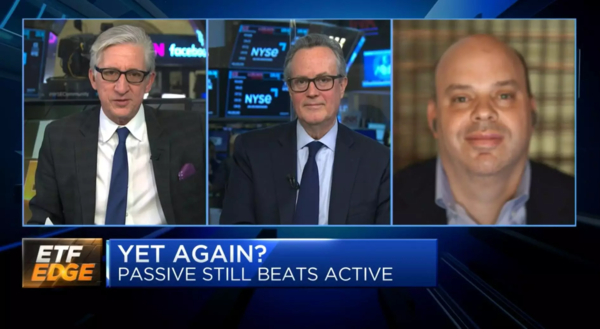S&P Global’s president and CEO, Doug Peterson, and ETF Trends and ETF Database’s head of research, Todd Rosenbluth, discuss the active versus passive fund performance gap on this week’s “ETF Edge” hosted by Bob Pisani on CNBC.
The S&P Dow Jones Indices released its annual report last week detailing the performance of active and passive mutual funds; the report found that 79% of active fund managers underperformed their benchmarks over the course of a 10-year period. Rosenbluth discusses the increasing flows into passive ETFs due to this trend.
“It just shows you that it’s hard to outperform, and it’s hard to outperform because it costs more for active managers when they’re trying to compete with the S&P 500 that is essentially free in the ETF wrapper,” Rosenbluth says.
Pisani discusses the wealth of research that has gone into this phenomenon and the general conclusion that despite any ability to outperform, much of the profits are eaten up in the high management fees that active funds charge, the difficulty surrounding the need to predict market performance both going into and out of trades and the high degree of smart competition in the active fund space.
“The average actively managed mutual fund charges 100 basis points; that’s already a high bar to overcome,” Rosenbluth says. ETFs such as the iShares Core S&P 500 ETF (IVV ), the Vanguard S&P 500 ETF (VOO ), and the SPDR Portfolio S&P 500 ETF (SPLG) all offer S&P 500 index investment options for 0.03%.
Content continues below advertisement
Investing in Passive Strategies and the Creation of Indexes
For advisors and investors seeking a more targeted approach within a category such as value, which has performed strongly in recent months, the Invesco S&P 500 Pure Value ETF RSV and the iShares MSCI USA Value Factor ETF (VLUE ) are two options that offer that exposure at a considerably reduced price point.
“You get the same exposure you might get from an active manager with that targeted favoring of value-oriented stocks, but you don’t have to worry about that manager letting winners run too much; it gets rebalanced out as it should be,” Rosenbluth explains.
Peterson closes by discussing the storied history of the S&P Dow Jones and the governance that goes into creating and maintaining each index and the committees that evaluate the economy and how the indexes are performing, and what to add or take from them over time.
“All of the index committees are managed in the same way, with a committee on the other side of a firewall, with a very strict governance and compliance process,” Peterson explains.
For more news, information, and strategy, visit ETF Trends.

